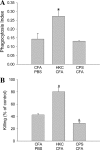Differential activation of peritoneal cells by subcutaneous treatment of rats with cryptococcal antigens
- PMID: 19494083
- PMCID: PMC2725545
- DOI: 10.1128/CVI.00100-09
Differential activation of peritoneal cells by subcutaneous treatment of rats with cryptococcal antigens
Abstract
Previous studies in our laboratory have shown that the subcutaneous pretreatment of rats with heat-killed cells (HKC) of Cryptococcus neoformans emulsified in complete Freund adjuvant (CFA) promotes protective immunity against an intraperitoneal challenge with C. neoformans. In contrast, subcutaneous treatment with the capsular polysaccharide (PSC) emulsified in CFA exacerbates the cryptococcal infection. The purpose of this study was to analyze the mechanisms involved in these phenomena. Adherent peritoneal cells from rats treated with HKC-CFA showed upregulated ED2, CD80, and CD86 expression; an increase in the level of production of anticryptococcal metabolites; and the enhanced production of interleukin-12 (IL-12) in comparison with the findings for cells from rats treated with CFA-phosphate-buffered saline (PBS). Adherent peritoneal cells from rats treated with PSC-CFA, however, also presented upregulated ED2, CD80, and CD86 expression compared to the level of expression for peritoneal cells from controls, but these cells showed an increase in arginase activity and decreased levels of production of IL-12 and tumor necrosis factor (TNF) compared with the activity and levels of production by peritoneal cells from CFA-PBS-treated rats. In addition, treatment with HKC-CFA resulted in a rise in the phagocytic and anticryptococcal activities of adherent peritoneal cells compared to those for control rats. However, adherent peritoneal cells from rats treated with PSC-CFA presented a reduction in anticryptococcal activity in comparison with that for cells from animals treated with CFA-PBS. These results show the differential activation between adherent peritoneal cells from HKC-CFA- and PSC-CFA-treated rats, with this differential activation at the primary site of infection possibly being responsible, at least in part, for the phenomena of protection and exacerbation observed in our model.
Figures






Similar articles
-
Treatment of rats with heat killed cells (HKC) of Cryptococcus neoformans var. grubii induces cellular activation in spleen and lymphatic nodes.Comp Immunol Microbiol Infect Dis. 2011 Jul;34(4):327-34. doi: 10.1016/j.cimid.2011.04.002. Epub 2011 May 17. Comp Immunol Microbiol Infect Dis. 2011. PMID: 21592577
-
Heat killed cells of Cryptococcus neoformans var. grubii induces protective immunity in rats: immunological and histopathological parameters.Med Mycol. 2006 Sep;44(6):493-504. doi: 10.1080/13693780600750022. Med Mycol. 2006. PMID: 16966166
-
Regulation of cytokine expression in mice immunized with cryptococcal polysaccharide, a glucuronoxylomannan (GXM), associated with peritoneal antigen-presenting cells (APC): requirements for GXM, APC activation, and interleukin-12.Infect Immun. 2000 Sep;68(9):5146-53. doi: 10.1128/IAI.68.9.5146-5153.2000. Infect Immun. 2000. PMID: 10948138 Free PMC article.
-
Polysaccharide antigens of the capsule of Cryptococcus neoformans.Infect Immun. 1994 May;62(5):1507-12. doi: 10.1128/iai.62.5.1507-1512.1994. Infect Immun. 1994. PMID: 8168912 Free PMC article. Review.
-
Polysaccharides, mimotopes and vaccines for fungal and encapsulated pathogens.Trends Microbiol. 2001 Sep;9(9):445-51. doi: 10.1016/s0966-842x(01)02134-5. Trends Microbiol. 2001. PMID: 11553457 Review.
Cited by
-
Host-pathogen interaction between macrophage co-cultures with Staphylococcus aureus biofilms.Eur J Clin Microbiol Infect Dis. 2021 Dec;40(12):2563-2574. doi: 10.1007/s10096-021-04306-2. Epub 2021 Jul 27. Eur J Clin Microbiol Infect Dis. 2021. PMID: 34312744
References
Publication types
MeSH terms
Substances
LinkOut - more resources
Full Text Sources
Molecular Biology Databases

